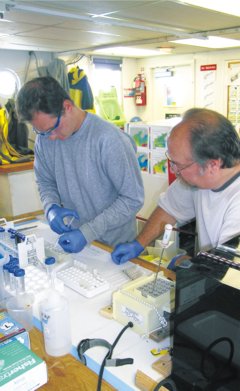
Red tide studies to be expanded
Printer Friendly Page
 |
PHOTO: MIKE CARLOWICZ, WOODS HOLE OCEANOGRAPHIC INSTITUTION |
Researchers at the Woods Hole Oceanographic Institution (WHOI) and colleagues from seven other universities and agencies began the five-year Gulf of Maine Toxicity program, or GOMTOX, in September 2006. The $7.5-million program is funded by a grant from the National Oceanic & Atmospheric Administration's (NOAA) National Ocean Service.
The research expands past studies in the Gulf of Maine and builds on data collected during the historic 2005 red tide, which led to closure of both near shore shellfish beds and offshore beds in federal waters out to Georges Bank. The toxicity also extended for the first time to the islands of Martha's Vineyard and Nantucket in Massachusetts.
Large portions of the Gulf of Maine and its adjacent southern New England shelf are frequently contaminated with paralytic shellfish poisoning toxins produced by the dinoflagellate Alexandrium fundyense. The 2005 outbreak caused millions of dollars in economic damage, but monitoring programs and cooperation among federal, state and local officials, scientists, and shellfish fishermen prevented any reported cases of illness from people eating contaminated shellfish.
“As a result of the 2005 bloom and the closures in federal waters offshore and on the Cape and Islands, we realized we needed to expand efforts and develop a full, regional-scale understanding of Alexandrium fundyense blooms,” lead investigator Don Anderson of WHOI said.
GOMTOX will use a combination of large- and small-scale survey cruises, autonomous gliders, moored instruments and traps, drifters, satellite imagery, and numerical models.
In addition to WHOI researchers, scientists participating in GOMTOX represent Fisheries and Oceans Canada, NOAA's Northeast Fisheries Science Center, the Canadian National Research Council, the U.S. Food and Drug Admin-istration, University of Maine, University of Massachusetts, and the Stellwagen Bank National Marine Sanctuary.
For more information visit http://www.whoi.edu/sbl/liteSite.do?litesiteid=13193.
© 2007 The Gulf of Maine Times